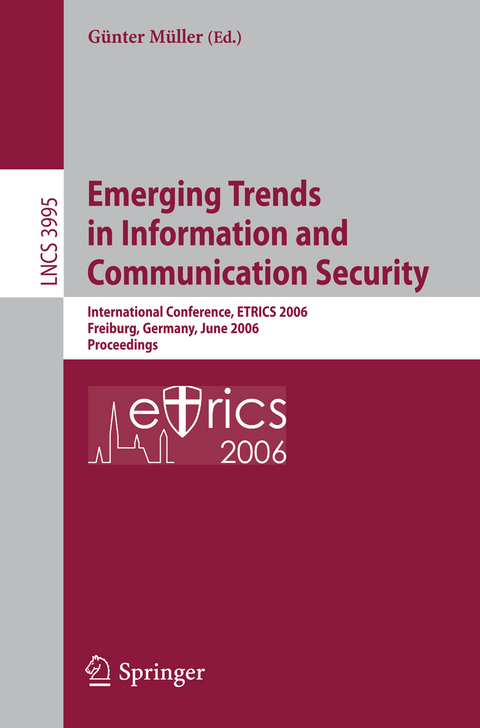
Emerging Trends in Information and Communication Security
Springer Berlin (Verlag)
978-3-540-34640-1 (ISBN)
Günter Müller is senior scientist for Biochemistry at Aventis Pharma Germany, Frankfurt am Main, and honorary lecturer for genetics at the University of Munich. He was born in Peissenberg (Germany) and studied anthropology, zoology, genetics and biochemistry at the Ludwig-Maximilians-University in Munich, finishing his PhD thesis under the supervision of R. Zimmermann in 1987. After post-doctoral fellowships at the universities of Ulm and Heidelberg, he joined the pharmaceutical industry in 1990 and received his habilitation at the University of Munich in 1996. He is interested in molecular mechanisms in both lower eukaryotes and mammalian cells, and their use as drug targets for metabolic disorders.
Multilateral Security.- Multilateral Security: Enabling Technologies and Their Evaluation.- Do You Trust Your Recommendations? An Exploration of Security and Privacy Issues in Recommender Systems.- Security in Service-Oriented Computing.- Optimized Workflow Authorization in Service Oriented Architectures.- Dynamic Layer-2 VPN Services for Improving Security in the Grid Environment.- A P2P Content Authentication Protocol Based on Byzantine Agreement.- Secure Mobile Applications.- Transitive Trust in Mobile Scenarios.- An Open, PKI-Based Mobile Payment System.- Secure Rejoining Scheme for Dynamic Sensor Networks.- Developing Provable Secure M-Commerce Applications.- Enterprise Privacy.- An Algebra for Enterprise Privacy Policies Closed Under Composition and Conjunction.- Privacy-Preserving Decision Tree Mining Based on Random Substitutions.- Privacy, Identity, and Anonymity.- Policy-Based Integration of User and Provider-Sided Identity Management.- Privacy with Delegation of Rights by Identity Management.- A Framework for Quantification of Linkability Within a Privacy-Enhancing Identity Management System.- Revocable Anonymity.- Low Latency Anonymous Communication - How Long Are Users Willing to Wait?.- Security Engineering.- Security Engineering Using Problem Frames.- SecTOOL - Supporting Requirements Engineering for Access Control.- Possibilistic Information Flow Control in MAKS and Action Refinement.- Toward a Framework for Forensic Analysis of Scanning Worms.- A Comparison of Market Approaches to Software Vulnerability Disclosure.- Reliable Keystroke Biometric System Based on a Small Number of Keystroke Samples.- Security Policies.- Allowing State Changes in Specifications.- Field Access Analysis for Enforcing Access Control Policies.- Controlling Access toDocuments: A Formal Access Control Model.- How to Increase the Security of Digital Rights Management Systems Without Affecting Consumer's Security.- Security and Protocols.- Secure End-to-End Transport over SCTP.- An Extended Model of Rational Exchange Based on Dynamic Games of Imperfect Information.- Filtering for Private Collaborative Benchmarking.- Intrusion Detection.- On the Use of Word Networks to Mimicry Attack Detection.- Simplifying Signature Engineering by Reuse.- Redesign and Implementation of Evaluation Dataset for Intrusion Detection System.- Requirements of Information Reductions for Cooperating Intrusion Detection Agents.- Perspectives of Cryptographic Security.- Quantum Algorithm for Solving the Discrete Logarithm Problem in the Class Group of an Imaginary Quadratic Field and Security Comparison of Current Cryptosystems at the Beginning of Quantum Computer Age.- Kleptographic Attacks on E-Voting Schemes.- Visual Document Authentication Using Human-Recognizable Watermarks.
| Erscheint lt. Verlag | 6.6.2006 |
|---|---|
| Reihe/Serie | Lecture Notes in Computer Science | Security and Cryptology |
| Zusatzinfo | XX, 532 p. |
| Verlagsort | Berlin |
| Sprache | englisch |
| Maße | 155 x 235 mm |
| Gewicht | 767 g |
| Themenwelt | Informatik ► Theorie / Studium ► Kryptologie |
| Schlagworte | Access Control • anonymity • Communication • Communications Security • Data Security • E-Voting • Identity • Information • Information protection • Information Security • Network Security • PKI • privacy • security • security architectures • security protocols • service-oriented computing • service security • Systems Security |
| ISBN-10 | 3-540-34640-6 / 3540346406 |
| ISBN-13 | 978-3-540-34640-1 / 9783540346401 |
| Zustand | Neuware |
| Haben Sie eine Frage zum Produkt? |
aus dem Bereich


